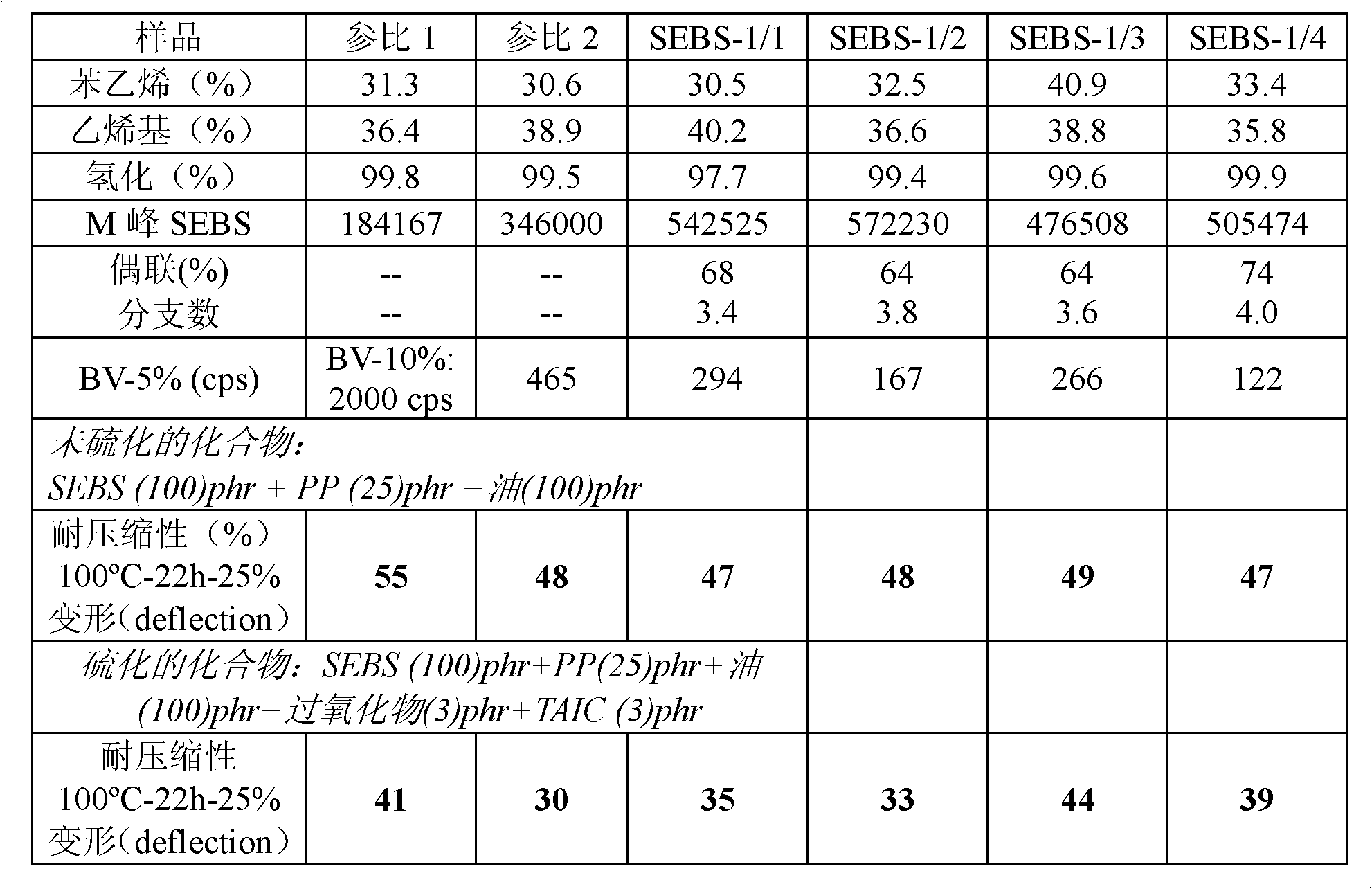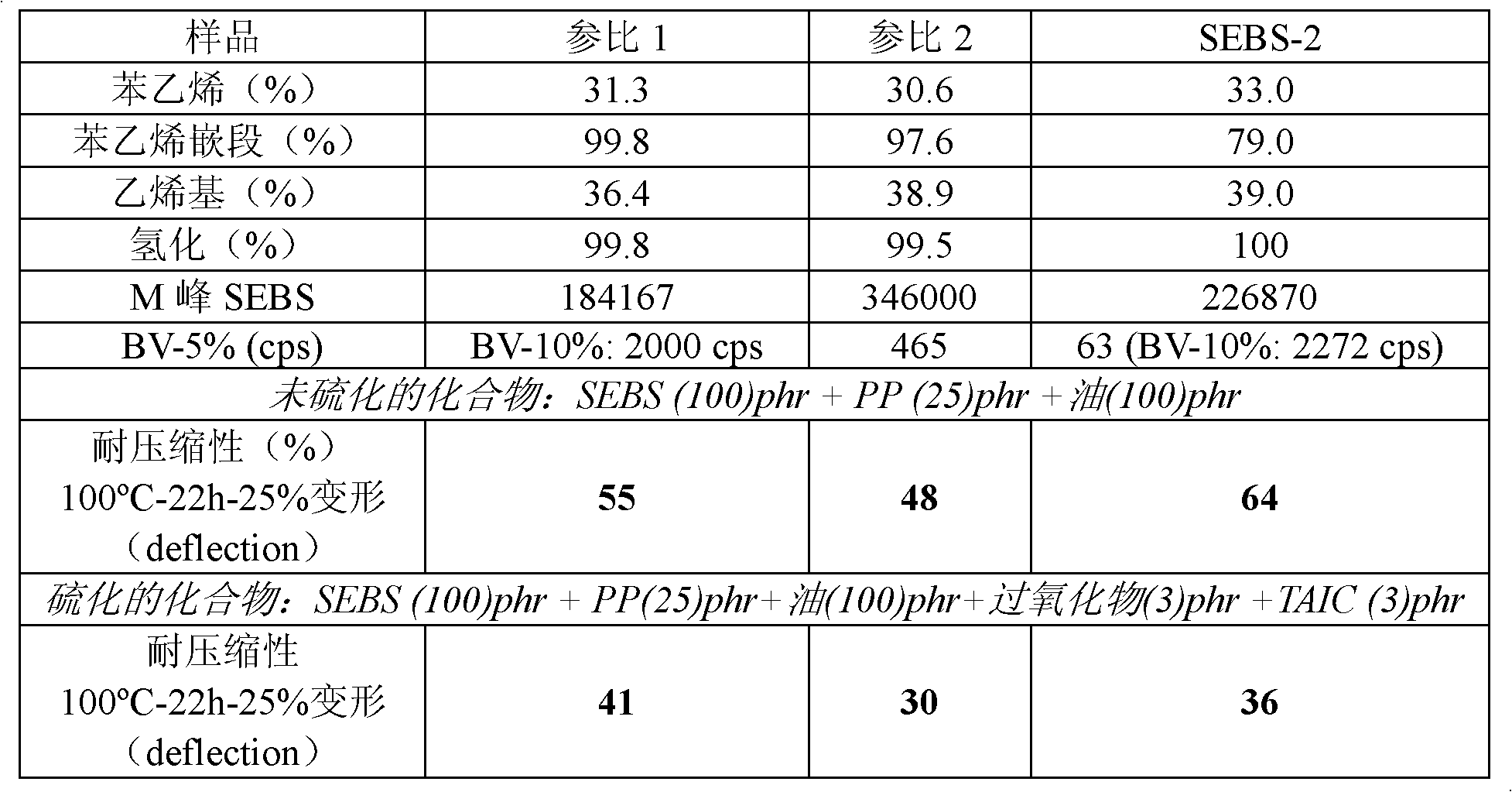Hydrogenated rubber with improved high-temperature properties
A linear and elastomer technology, applied in the field of high molecular weight hydrogenated styrene/butadiene rubber, which can solve the problems of loss of mechanical resistance and insufficient compression resistance, and achieve improved characteristics, compression resistance and processability. Effect
- Summary
- Abstract
- Description
- Claims
- Application Information
AI Technical Summary
Problems solved by technology
Method used
Image
Examples
Embodiment 1
[0077] Example 1: SEBS-1
[0078] The following were introduced into a stirred reactor (CSTR) at concentrations sufficient (200 ppm) to achieve the target vinyl level: cyclohexane (6.509 g) as solvent, styrene (1.371 g, 25% by weight solution) as mono (9% solids), n-butyllithium as primer and polar modifier (1,2-diethoxypropane).
[0079] Polymerization was allowed to occur at a temperature of 65°C, wherein the total time of this step was never greater than 30 minutes, controlling the temperature peaks associated with styrene polymerization. Once it was decided to proceed with styrene polymerization, butadiene (682 g) was added to the reactor and polymerization was allowed to occur for a time determined to be 10 minutes after the maximum temperature peak. Once it was decided to proceed with the butadiene polymerization, the coupling agent (silicon tetrachloride) was added at a molar ratio of 0.3 relative to the active lithium and the coupling reaction was allowed to take plac...
Embodiment 2
[0085] Example 2: SEBS-2
[0086] The following were introduced into a stirred reactor (CSTR) at concentrations sufficient (200 ppm) to achieve target vinyl and block levels: cyclohexane (5.638 g) as solvent, styrene (810 g, 25% by weight solution) and butadiene (10 ml) as comonomer, n-butyllithium as primer and polar modifier (1,2-diethoxypropane).
[0087] Polymerization was allowed to occur at a temperature of 70°C, wherein the total time of this step was never greater than 35 minutes, controlling the temperature peaks associated with styrene polymerization. Once it was decided to proceed with styrene polymerization, butadiene (619 g) was added to the reactor and polymerization was allowed to occur for a time determined to be 10 minutes after the maximum temperature peak. Once it was decided to proceed with the polymerization of butadiene, styrene (810 g, 25% total solution) and butadiene (10 ml) were simultaneously introduced into the reactor as comonomers. After the dif...
Embodiment 3
[0091] Example 3: SEBS-3
[0092] The following were introduced into the stirred reactor (CSTR) at concentrations sufficient (200 ppm) to achieve the target vinyl and block levels: cyclohexane (5,526 g) as solvent, styrene (1,292 g, 25% by weight solution) and butadiene (10 ml) as comonomer, n-butyllithium as primer and polar modifier (1,2-diethoxypropane). Polymerization was allowed to occur at a temperature of 65°C, wherein the total time of this step was never greater than 30 minutes, controlling the temperature peaks associated with styrene polymerization. Once it was decided to proceed with styrene polymerization, butadiene (675 g) was added to the reactor and polymerization was allowed to occur for a time determined to be 10 minutes after the maximum temperature peak. Once it was decided to proceed with the butadiene polymerization, the coupling agent (silicon tetrachloride) was added at a molar ratio of 0.3 relative to the active lithium and the coupling reaction was a...
PUM
 Login to View More
Login to View More Abstract
Description
Claims
Application Information
 Login to View More
Login to View More - R&D
- Intellectual Property
- Life Sciences
- Materials
- Tech Scout
- Unparalleled Data Quality
- Higher Quality Content
- 60% Fewer Hallucinations
Browse by: Latest US Patents, China's latest patents, Technical Efficacy Thesaurus, Application Domain, Technology Topic, Popular Technical Reports.
© 2025 PatSnap. All rights reserved.Legal|Privacy policy|Modern Slavery Act Transparency Statement|Sitemap|About US| Contact US: help@patsnap.com



